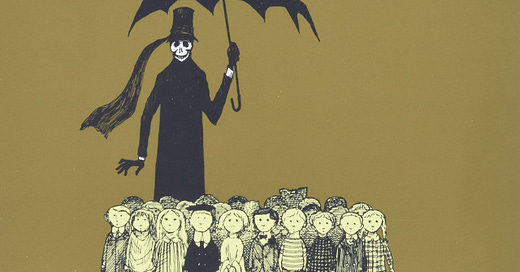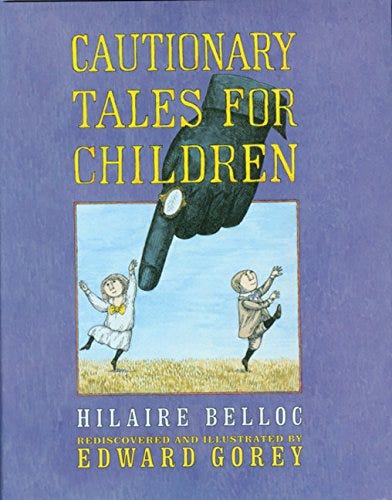Tales, Folktales, Fairy Tales, Fables (grim elements of)
If you really are pursuing the idea of starting a nursery school modeled on the Misses Leighton’s school, you will want to begin building a library of books like the ones from which Mr. Beaker and Miss Louisa read the two versions of the fable of the fox and the clam that we have seen so far. Allow me to suggest:
The Gashlycrumb Tinies, or After the Outing, by Edward Gorey
“A is for Amy who fell down the stairs. B is for Basil assaulted by bears. C is for Clara who wasted away. D is for Desmond thrown out of a sleigh. . .”
Cautionary Tales for Children, by Hilaire Belloc
“Algernon: Who played with a Loaded Gun, and, on missing his Sister, was reprimanded by his Father. … Rebecca: Who Slammed Doors For Fun and Perished Miserably. … George: Who played with a Dangerous Toy, and suffered a Catastrophe of considerable Dimensions.”
The Original Folk and Fairy Tales of the Brothers Grimm: The Complete First Edition, translated by Jack Zipes
From The Guardian review:
Thanks to Zipes, we can now read the horrific tales of Rapunzel, Cinderella, Hansel and Gretel, and Sleeping Beauty as they were originally written- complete with blood, death, and terrible mothers. The trope we know today of the ‘evil stepmother’ was one of the changes made over the years because, according to Zipes, they had to uphold the view that motherhood was “sacred”. In the original stories it is actually Snow White’s own mother who orders the huntsman to murder her daughter and cut out her liver for her to eat, and Hansel and Gretel’s mother, not father or step mother, who abandons them in the forest.
“The original edition was not published for children or general readers. Nor were these tales told primarily for children. It was only after the Grimms published two editions primarily for adults that they changed their attitude and decided to produce a shorter edition for middle-class families. This led to Wilhelm’s editing and censoring many of the tales.”
It is no wonder a few of the stories were removed as some of them were truly bizarre tales of infanticide and suffering. How The Children Played at Slaughtering is a terrible tale of a child who accidentally kills their brother, only to be murdered by their mother, who neglects her other child in the bath, and they drown. The deaths don’t stop there as the mother hangs herself in despair, and when the father returns home he dies soon after from a broken heart. The Children of Famine is as jolly as the title suggests, and yes pretty much everyone dies.
[more to come on Friday, October 7, 2021]
Have you missed an episode or two or several?
You can catch up by visiting the archive or consulting the index to the Topical Guide.
You can listen to the episodes on the Personal History podcast. Begin at the beginning or scroll through the episodes to find what you’ve missed.
At Apple Books you can download free eBooks of “My Mother Takes a Tumble,” “Do Clams Bite?,” “Life on the Bolotomy,” and “The Static of the Spheres,” the first four novellas in Little Follies.
You’ll find an overview of the entire work in An Introduction to The Personal History, Adventures, Experiences & Observations of Peter Leroy. It’s a pdf document.







